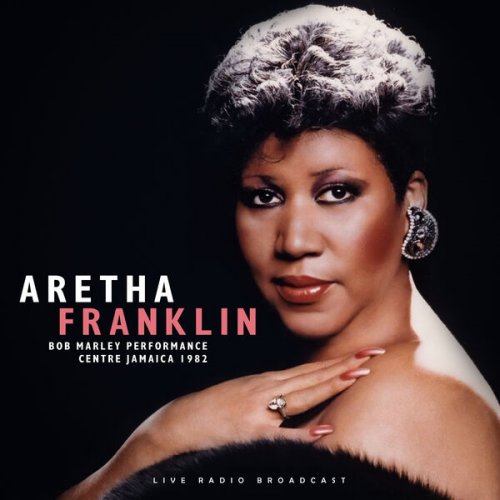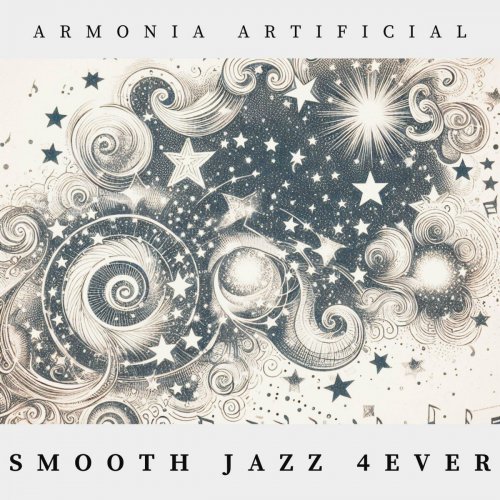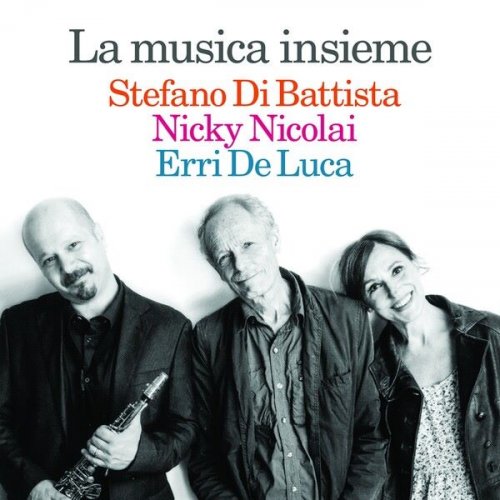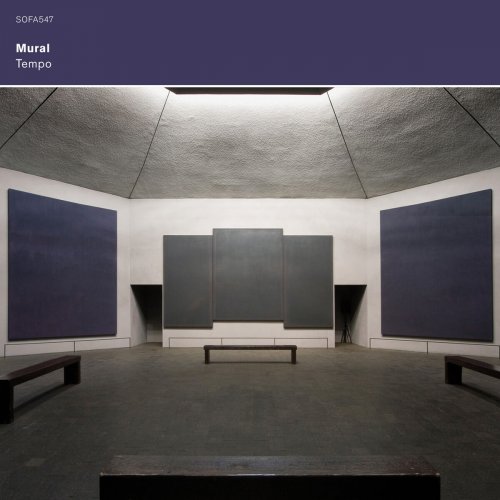Groundhogs - Back Against The Wall (Reissue) (1986/1994)
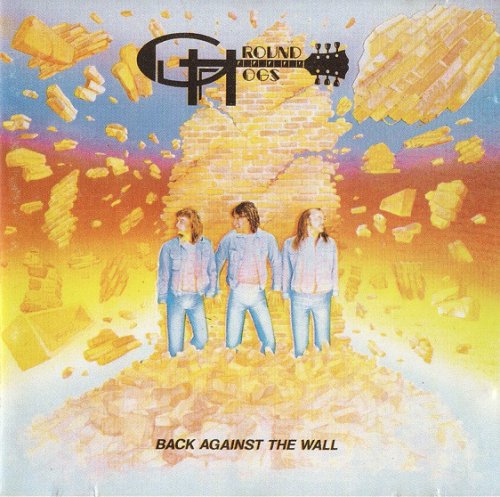
Artist: Groundhogs
Title: Back Against The Wall
Year Of Release: 1986/1994
Label: The Magnum Music Group
Genre: Blues Rock, British Blues
Quality: Flac (tracks, .cue, log)
Total Time: 39:13
Total Size: 163/297 Mb (scans)
WebSite: Album Preview
Title: Back Against The Wall
Year Of Release: 1986/1994
Label: The Magnum Music Group
Genre: Blues Rock, British Blues
Quality: Flac (tracks, .cue, log)
Total Time: 39:13
Total Size: 163/297 Mb (scans)
WebSite: Album Preview
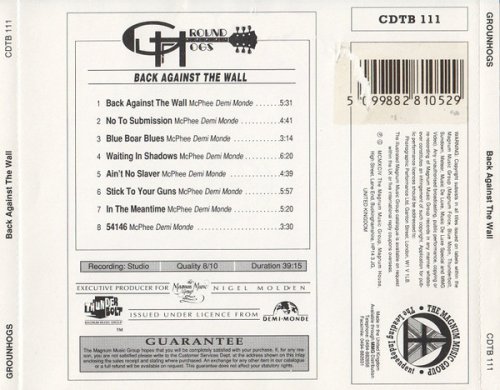
Tracklist:
01. Back Against The Wall
02. No To Submission
03. Blue Boar Blues
04. Waiting In Shadows
05. Ain't No Slaver
06. Stick To Your Guns
07. In The Meantime
08. 54146
Line-up:
Bass – Dave Anderson
Drums, Percussion – Mick Jones
Guitar, Vocals – Tony McPhee
Written-By – Tony McPhee
The Groundhogs and Tony (T.S.) McPhee
Known primarily as a hard rock / blues rock group, the Groundhogs have become a legend in the world of rock, they never set out to become a Prog rock band though during 1970 - 72 created some imaginative experimental music born from the pen of Tony McPhee, and made much of the band's work interesting material for followers of Prog - social, mindwarp, ecological and psyche/space rock themes and unusual instruments found their way into the band's albums made during this their most progressive and arguably most fruitful period, featuring many regard as the classic Groundhogs line-up of Tony (T.S.) McPhee guitar/vocals, Pete Cruikshank on bass guitar and Ken Pustelnik on drums.
The Groundhogs originally began as "John Lee's Groundhogs", who coincidentally went on to back the great bluesman John Lee Hooker during some of his trips to the UK and recorded their first session with him in 1964. In 1968 during the great UK blues boom The Groundhogs continued to tour as a blues group, supported Led Zeppelin among others and recorded "Scratching The Surface" at the Marquee Club studio. With the end of the blues boom in 69, (their second album "Blues Obituary" shows the band on the sleeve ceremoniously "burying" the blues) the band had to come up with a new direction - which came with the release of "Thank Christ for the Bomb".
Intending to create something away from the blues, manager Roy Fisher, thinking of a concept Tony could work on, came up with the inflammatory phrase "Thank Christ for the Bomb".
At the time the cold war with Russia was still deep in the public psyche, "Ban the Bomb" marches still occupied the press, the album title statement was an antedote to all this, saying that the nuclear standoff would stop nuclear wars happening in the future - and here we are 39 years later and still no World War Three nuclear holocaust in sight..yet. The album consists of nine tracks, side one has the suite of four songs "Strange Town", "Darkness is no Friend", " Soldier" and "Thank Christ for the Bomb", ending in a huge ..BOOOOM!
Guaranteed to raise controversy for such a sensitive political subject, the album was nevertheless well received by champion-of -Prog DJ John Peel who aired "Soldier" and sales for the album rocketed.
Tony didn't have to look far for the inspiration behind material for his next album of songs - after suffering a nervous breakdown which occurred some weeks after briefly experimenting with grass "Split" was conceived from these experiences, and gave a musical soundscape of what happens when one is losing his mind - panic stricken vocals, twisting, screaming, thrashing heavily distorted guitar backed by relentless throbbing bass lines and crashing primeval drumming - the sweats, paranoia, confusion, panic, hallucinations, running scared then the depression that follows. This suite of four sections "Split Parts 1-4" , engineered by Martin Birch (fresh from finishing Deep Purple's recording of "In Rock") became the band's Tour de Force, the long-awaited follow-up to "Thank Christ." was a huge success and the band were on the map, only missing out on the coveted no.1 slot by an oversight by the record company - not enough albums had been pressed to meet demand, (this was hardly a sorry state of affairs for your average Prog band, fearing they may have "sold out"! ). The Groundhogs were still a blues band but they were playing way out of their skin, and bursting through into Prog Rock territory - many had compared The Groundhogs as a second rate Cream, but this proved they could go way deeper than psychedelic blues/pop songs, by now Progressive rock fans were taking notice, but were berated by the critics (like every good Prog Rock band should be!). By this time the band had been appearing on the same bills with such artists as Arthur Brown, Colosseum, Black Sabbath, The Nice, King Crimson and Van der Graaf Generator.
"Who Will Save The World?" pressed home the message that The Groundhogs were pursuing more controversial themes in their music - though on the face of it things seemed fairly light-hearted, even tongue-in-cheek - the cartoon cover designed by comics illustrator Neal Adams (incidentally the bass drum artwork in the band photo above was designed by Genesis album cover illustrator Paul Whitehead) told the story of our three protagonists challenging the three main forces of evil - Pollution, Overpopulation and War - through their music (and the odd right hook!). The album contains an eclectic collection of songs littered with word-play and considered by many as the band's Proggiest , and the band's most difficult work to date. Some have dark ecological sci-fi messages (which belie the frivolous story on the cover) such as "Earth Is Not Room Enough" (featuring mellotron for the first time) "Wages of Peace" and "Death of the Sun" intermingled with such follies as "Bog Roll Blues" and "Amazing Grace" played on guitar and a rather clackety Harmonium - all typical fare for most Prog albums of the time and littered with those odd time signatures and one freaked-out ten minute epic "The Grey Maze", this band were a loud exciting experience live - "three ordinary guys crawling onto the stage and smashing into it!"
Following a riding accident in the United States in which Tony broke his wrist and so sadly cut short the "Who Will Save The World" tour (and cut short much needed promotion for the new album in the USA), the following album "Hogwash" was a more experimental affair, as Tony was temporarily limited on the guitar. A Mellotron which was used on the previous album and Synthesisers were brought forward into the band's music with great effect, drummer Ken Pustlenik left and ex-Egg drummer Clive Brooks was brought in to replace him, also adding a new dimension to the band's sound. "Hogwash" was a different animal to the preceding albums, again featuring socio-political and sci-fi song themes, and listing "Astronic Equalisers", "Schaller wah wah's" and "Ring Modulators" into the mix, the Ring Modulator was used to good effect on the aptly named "The Ringmaster" , some clever word play on "I Love You Miss Ogyny" and on " S'One Song" (Swan Song), and the deeper songs awash with a "sea" of Mellotron on the ecological / sci-fi yarn "Earth Shanty" (the nearest the band came to creating a Prog epic), and the first signs of Tony's abhorrence with hunting "SAD IS The Hunter" (SADIST.).
During Tony's dalliances with Synthesisers and Mellotrons he became a master of the keyboards, producing his first solo album "Two Sides of Tony McPhee", a very personal work (naturally) particularly concentrating on the subject of fox hunting - this vile practice was always abhorrent to Tony and indeed most of us, and the cruel nature of the course of a day's fox hunt is reflected in the whole of side two using Electronic Synthesisers in a piece entitled "The Hunt". The Synthesisers are used to good effect simulating the chase, the animal's last dying moments and the baying of the advancing hounds and overall is a very progressive and involving piece. The "Other" side of Tony is pure blues.
The Groundhogs continued to have many personnel changes over the years and their following albums stuck to straight rock and Country Blues (all containing some great songs), as were other bands of the time, the wild innovative guitar style and unique songwriting continued too up until the last studio album of original material "Backs to the Wall" in 1987 . The band "Tony McPhee and the Groundhogs" still continue to tour regularly, old band members return, Tony plays many songs from the band's progressive period interspersed with Blues songs, which he continues to record, new generations of fans are realising his amazing talent, and his old friend Captain Sensible's description of Tony as "England's Jimi Hendrix" is not so far from the truth.
Known primarily as a hard rock / blues rock group, the Groundhogs have become a legend in the world of rock, they never set out to become a Prog rock band though during 1970 - 72 created some imaginative experimental music born from the pen of Tony McPhee, and made much of the band's work interesting material for followers of Prog - social, mindwarp, ecological and psyche/space rock themes and unusual instruments found their way into the band's albums made during this their most progressive and arguably most fruitful period, featuring many regard as the classic Groundhogs line-up of Tony (T.S.) McPhee guitar/vocals, Pete Cruikshank on bass guitar and Ken Pustelnik on drums.
The Groundhogs originally began as "John Lee's Groundhogs", who coincidentally went on to back the great bluesman John Lee Hooker during some of his trips to the UK and recorded their first session with him in 1964. In 1968 during the great UK blues boom The Groundhogs continued to tour as a blues group, supported Led Zeppelin among others and recorded "Scratching The Surface" at the Marquee Club studio. With the end of the blues boom in 69, (their second album "Blues Obituary" shows the band on the sleeve ceremoniously "burying" the blues) the band had to come up with a new direction - which came with the release of "Thank Christ for the Bomb".
Intending to create something away from the blues, manager Roy Fisher, thinking of a concept Tony could work on, came up with the inflammatory phrase "Thank Christ for the Bomb".
At the time the cold war with Russia was still deep in the public psyche, "Ban the Bomb" marches still occupied the press, the album title statement was an antedote to all this, saying that the nuclear standoff would stop nuclear wars happening in the future - and here we are 39 years later and still no World War Three nuclear holocaust in sight..yet. The album consists of nine tracks, side one has the suite of four songs "Strange Town", "Darkness is no Friend", " Soldier" and "Thank Christ for the Bomb", ending in a huge ..BOOOOM!
Guaranteed to raise controversy for such a sensitive political subject, the album was nevertheless well received by champion-of -Prog DJ John Peel who aired "Soldier" and sales for the album rocketed.
Tony didn't have to look far for the inspiration behind material for his next album of songs - after suffering a nervous breakdown which occurred some weeks after briefly experimenting with grass "Split" was conceived from these experiences, and gave a musical soundscape of what happens when one is losing his mind - panic stricken vocals, twisting, screaming, thrashing heavily distorted guitar backed by relentless throbbing bass lines and crashing primeval drumming - the sweats, paranoia, confusion, panic, hallucinations, running scared then the depression that follows. This suite of four sections "Split Parts 1-4" , engineered by Martin Birch (fresh from finishing Deep Purple's recording of "In Rock") became the band's Tour de Force, the long-awaited follow-up to "Thank Christ." was a huge success and the band were on the map, only missing out on the coveted no.1 slot by an oversight by the record company - not enough albums had been pressed to meet demand, (this was hardly a sorry state of affairs for your average Prog band, fearing they may have "sold out"! ). The Groundhogs were still a blues band but they were playing way out of their skin, and bursting through into Prog Rock territory - many had compared The Groundhogs as a second rate Cream, but this proved they could go way deeper than psychedelic blues/pop songs, by now Progressive rock fans were taking notice, but were berated by the critics (like every good Prog Rock band should be!). By this time the band had been appearing on the same bills with such artists as Arthur Brown, Colosseum, Black Sabbath, The Nice, King Crimson and Van der Graaf Generator.
"Who Will Save The World?" pressed home the message that The Groundhogs were pursuing more controversial themes in their music - though on the face of it things seemed fairly light-hearted, even tongue-in-cheek - the cartoon cover designed by comics illustrator Neal Adams (incidentally the bass drum artwork in the band photo above was designed by Genesis album cover illustrator Paul Whitehead) told the story of our three protagonists challenging the three main forces of evil - Pollution, Overpopulation and War - through their music (and the odd right hook!). The album contains an eclectic collection of songs littered with word-play and considered by many as the band's Proggiest , and the band's most difficult work to date. Some have dark ecological sci-fi messages (which belie the frivolous story on the cover) such as "Earth Is Not Room Enough" (featuring mellotron for the first time) "Wages of Peace" and "Death of the Sun" intermingled with such follies as "Bog Roll Blues" and "Amazing Grace" played on guitar and a rather clackety Harmonium - all typical fare for most Prog albums of the time and littered with those odd time signatures and one freaked-out ten minute epic "The Grey Maze", this band were a loud exciting experience live - "three ordinary guys crawling onto the stage and smashing into it!"
Following a riding accident in the United States in which Tony broke his wrist and so sadly cut short the "Who Will Save The World" tour (and cut short much needed promotion for the new album in the USA), the following album "Hogwash" was a more experimental affair, as Tony was temporarily limited on the guitar. A Mellotron which was used on the previous album and Synthesisers were brought forward into the band's music with great effect, drummer Ken Pustlenik left and ex-Egg drummer Clive Brooks was brought in to replace him, also adding a new dimension to the band's sound. "Hogwash" was a different animal to the preceding albums, again featuring socio-political and sci-fi song themes, and listing "Astronic Equalisers", "Schaller wah wah's" and "Ring Modulators" into the mix, the Ring Modulator was used to good effect on the aptly named "The Ringmaster" , some clever word play on "I Love You Miss Ogyny" and on " S'One Song" (Swan Song), and the deeper songs awash with a "sea" of Mellotron on the ecological / sci-fi yarn "Earth Shanty" (the nearest the band came to creating a Prog epic), and the first signs of Tony's abhorrence with hunting "SAD IS The Hunter" (SADIST.).
During Tony's dalliances with Synthesisers and Mellotrons he became a master of the keyboards, producing his first solo album "Two Sides of Tony McPhee", a very personal work (naturally) particularly concentrating on the subject of fox hunting - this vile practice was always abhorrent to Tony and indeed most of us, and the cruel nature of the course of a day's fox hunt is reflected in the whole of side two using Electronic Synthesisers in a piece entitled "The Hunt". The Synthesisers are used to good effect simulating the chase, the animal's last dying moments and the baying of the advancing hounds and overall is a very progressive and involving piece. The "Other" side of Tony is pure blues.
The Groundhogs continued to have many personnel changes over the years and their following albums stuck to straight rock and Country Blues (all containing some great songs), as were other bands of the time, the wild innovative guitar style and unique songwriting continued too up until the last studio album of original material "Backs to the Wall" in 1987 . The band "Tony McPhee and the Groundhogs" still continue to tour regularly, old band members return, Tony plays many songs from the band's progressive period interspersed with Blues songs, which he continues to record, new generations of fans are realising his amazing talent, and his old friend Captain Sensible's description of Tony as "England's Jimi Hendrix" is not so far from the truth.

![Eric Demarsan - Roberte (Original Motion Picture Soundtrack / Remastered 2024) (2024) [Hi-Res] Eric Demarsan - Roberte (Original Motion Picture Soundtrack / Remastered 2024) (2024) [Hi-Res]](https://www.dibpic.com/uploads/posts/2024-05/1715766593_gbtzyojg7xyzb_600.jpg)
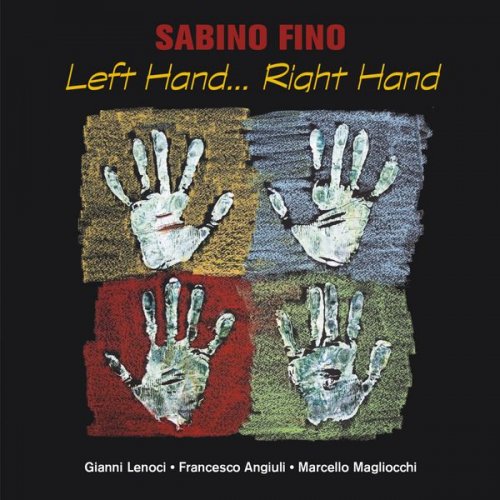
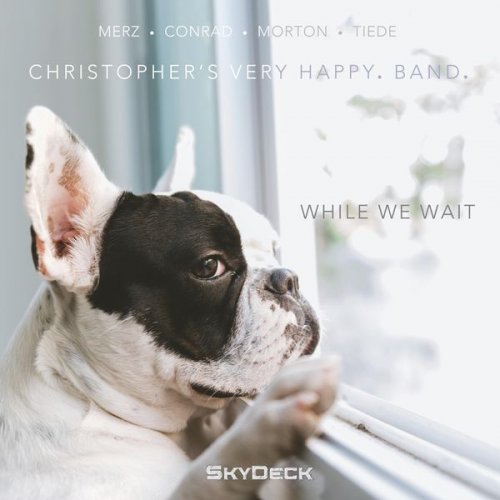
![Massimo De Mattia - Black Novel (2012) [Hi-Res] Massimo De Mattia - Black Novel (2012) [Hi-Res]](https://www.dibpic.com/uploads/posts/2024-05/1715535410_cover.jpg)
